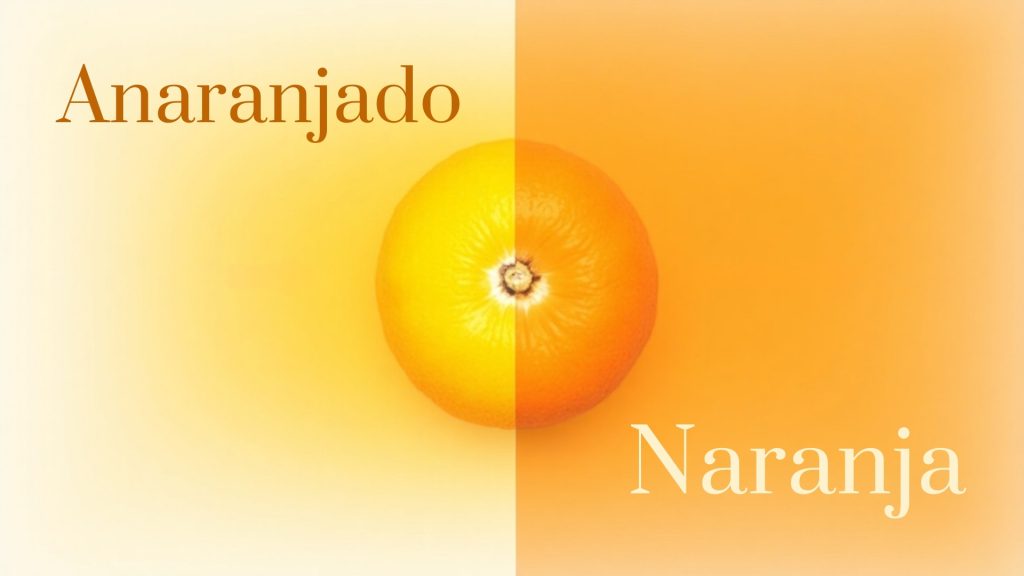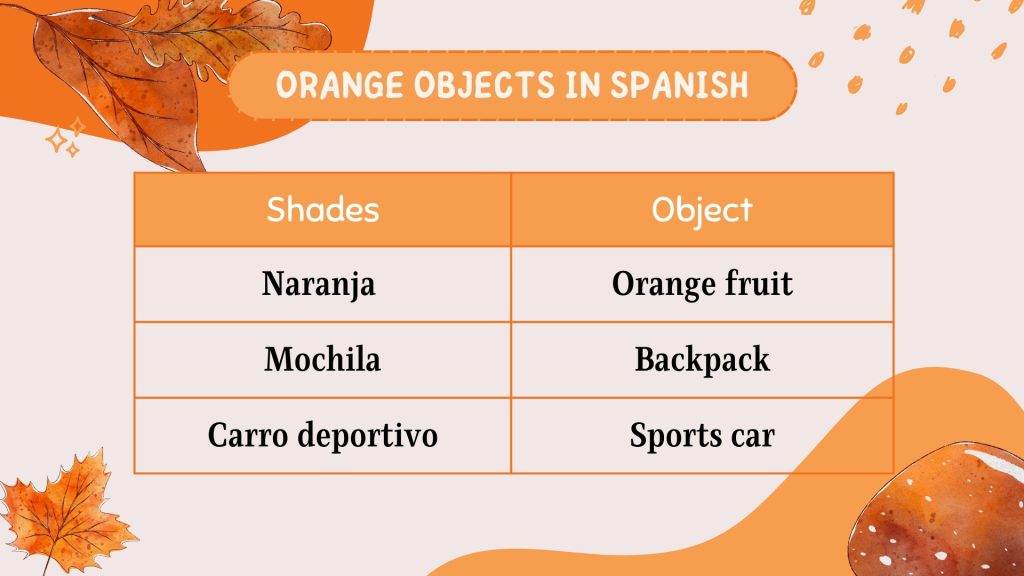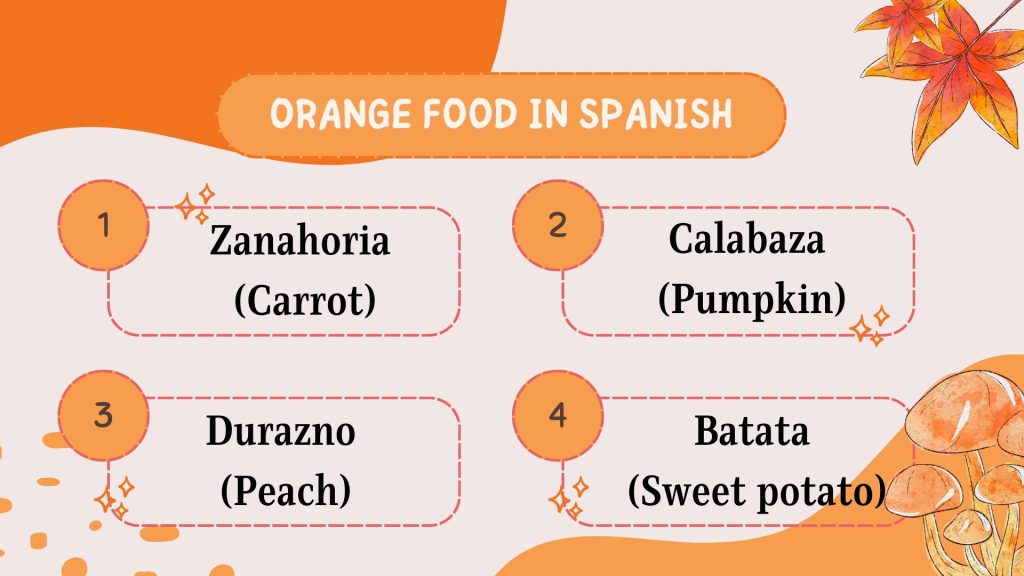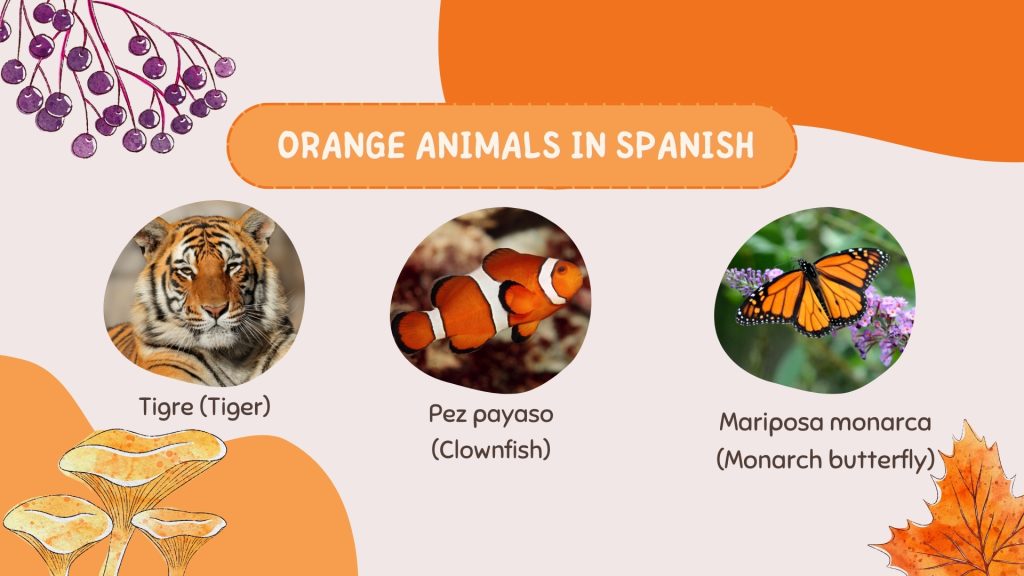In Spanish, the word for the color orange can be either ‘naranja’ or ‘anaranjado.’ ‘Naranja’ refers to both the color and the fruit, linking the word to more than just a visual sensation. It makes you think of the smell and taste too.
On the other hand, ‘anaranjado’ is just for the color. It might make you think of different shades, like the bright or soft tones of an orange.
This difference in words is interesting. It shows how language shapes the way we see and talk about colors. It’s worth digging into how people in different Spanish-speaking places use these words and what they mean to them.
Diferencia entre “naranja” y “anaranjado
In Spanish, the word ‘naranja’ means both the fruit and the color orange.
On the other hand, ‘anaranjado’ specifically describes a shade that looks like the orange fruit.

The Royal Spanish Academy says that ‘naranja’ can be used for both the fruit and the color. However, some people prefer ‘anaranjado’ when they want to talk about specific shades of orange.
| Difference | “Naranja” Usage | “Anaranjado” Usage |
|---|---|---|
| General Meaning | Refers to the pure, standard color orange. | Refers to specific shades or tones of orange. |
| Part of Speech | Can be both a noun (fruit) and an adjective (color). | Primarily an adjective, describing the shade of orange. |
| Use for Fruit | Used to refer to the fruit itself: la naranja (the orange). | Not used for the fruit; instead, it refers to the color. |
| Color Reference | Describes a general, vibrant orange color. | Describes a specific shade or variation of orange, like a pale or dark orange. |
| Singular Usage | La naranja (the orange) | El color anaranjado (the orange color) |
| Plural Usage | Las naranjas (the oranges) | Los colores anaranjados (the orange colors) |
| Shades of Orange | Does not indicate shade variation. | Indicates variations of orange like light, dark, or muted tones. |
| In Nature | Used to describe natural things like oranges, marigolds, etc. | Used to describe more specific hues of orange in nature, like sunsets or certain animals. |
| Use in Descriptions | Used in simple color descriptions: un coche naranja (an orange car). | Used for more artistic or descriptive contexts where a specific shade is intended: un atardecer anaranjado (an orange sunset). |
| Art and Design | Used to refer to the basic orange color. | Used when describing particular shades or when contrasting different tones of orange. |
Uso de “naranja” y “anaranjado” singular y plural
In Spanish, the word ‘naranja’ can be both a noun and an adjective. Interestingly, it stays the same whether you’re talking about one orange or several, so it’s pretty straightforward.
On the other hand, ‘anaranjado,’ which is only an adjective, changes based on gender and number. For a single masculine item, you say ‘anaranjado.’ If it’s feminine, you say ‘anaranjada.’ And for multiple items, you use ‘anaranjados’ or ‘anaranjadas,’ depending on whether they’re masculine or feminine.
Naranja
- Singular:
- La naranja (the orange)
Used to refer to the fruit or the color in its basic form when talking about a single object or entity. - Example: La naranja está madura. (The orange is ripe.)
- La naranja (the orange)
- Plural:
- Las naranjas (the oranges)
Used when talking about more than one orange, either the fruit or multiple objects with the color orange. - Example: Las naranjas son dulces. (The oranges are sweet.)
- Las naranjas (the oranges)
Anaranjado
- Singular:
- El color anaranjado (the orange color)
When describing a singular object with the color orange or referring to a single shade of orange. - Example: El color anaranjado de la flor es hermoso. (The orange color of the flower is beautiful.)
- El color anaranjado (the orange color)
- Plural:
- Los colores anaranjados (the orange colors)
Used when referring to multiple shades or variations of the color orange. - Example: Me gustan los colores anaranjados de la pintura. (I like the orange colors in the painting.)
- Los colores anaranjados (the orange colors)
Learn the key differences between the subjunctive and indicative in Spanish!
Shades of oranges in Spanish
Exploring orange shades in Spanish shows a wide range, from light orange to dark orange.
You can also find pastel orange, which adds a soft touch perfect for art and decor.

These colors are more than just pretty. They reflect the vibrant life and rich culture in Spanish-speaking areas.
- Naranja fuerte – Bright orange
- Naranja claro – Light orange
- Naranja oscuro – Dark orange
- Mandarina – Tangerine
- Durazno – Peach
- Cobre – Copper
- Amanecer – Sunrise orange
- Anaranjado neón – Neon orange
- Cantalupo – Cantaloupe orange
- Salmonado – Salmon color
Learn how to say and pronounce colors in Spanish with ease!
Orange objects in Spanish
In Spain, orange isn’t just a color; it pops up everywhere, from daily life to big festivals.
Take the marigold flowers, known as cempasúchil. These bright orange blooms are everywhere during the Day of the Dead celebrations.

And in Valencia, during the Fallas festival, you’ll see lots of women wearing vibrant orange dresses called falleras.
It’s a color that really stands out in Spanish culture.
- Naranja (Orange fruit)
- Zapatillas anaranjadas (Orange sneakers)
- Papel anaranjado (Orange paper)
- Flor de caléndula (Marigold flower)
- Pelota de tenis (Tennis ball)
- Carro deportivo (Sports car)
- Funda de almohada anaranjada (Orange pillowcase)
- Sombrero de paja (Straw hat)
- Silla de playa (Beach chair)
- Mochila (Backpack)
Orange Food in Spanish
Let’s keep exploring how the color orange pops in Spanish food.
Think about carrots, pumpkins, and sweet potatoes. These aren’t just colorful; they’re packed with good stuff for your body.

You’ll see these orange foods a lot in Spanish cooking. They add some punch to the flavor and make dishes look great, too.
- Zanahoria (Carrot)
- Mango (Mango)
- Calabaza (Pumpkin)
- Naranja (Orange)
- Pimiento naranja (Orange bell pepper)
- Batata (Sweet potato)
- Durazno (Peach)
- Cantalupo (Cantaloupe)
- Guisante zanahoria (Carrot pea soup)
- Sopa de calabaza (Pumpkin soup)
Orange animals in Spanish
Orange colors many animals in the Spanish-speaking world, each one unique in its own way. The ‘mariposa monarca’, or monarch butterfly, travels across continents.
Meanwhile, the ‘pez payaso’, known as the clownfish, lives in coral reefs.

Then there’s the ‘gallo de roca’, a bird that brightens the Andean forests.
And don’t forget the ‘tigre’, or tiger, that roams the jungles. Each of these animals shows how vibrant orange can be in nature.
- Tigre (Tiger)
- Pez payaso (Clownfish)
- León marino (Sea lion)
- Mariposa monarca (Monarch butterfly)
- Mandarín (Pájaro) (Mandarin duck)
- Lagarto de collar (Collared lizard)
- Marmota (Groundhog)
- Camaleón de pantera (Panther chameleon)
- Pavo real (Peacock)
- Cangrejo (Crab, often orange varieties)
Conclusion
In short, in Spanish, you can say ‘naranja’ or ‘anaranjado’ when you’re talking about the color orange. These words help describe different shades of orange you might see in things like fruits, animals, or even sunsets.
It’s pretty interesting how one color can have such importance and vary so much, right? Knowing these words helps us get a better grip on how language and culture come together, especially when it comes to something as everyday as colors.
It’s a cool way to see how vibrant and full of life the color orange can be in the Spanish-speaking world.
Unlock new opportunities by learning From Lingua Viva!
Born in Cali, but raised in London, Juan Pablo has led an interesting life. He has an undergraduate degree in Foreign Language and 10+ years of experience. Juan Pablo has taught and worked as a professor and interpreter in Spanish, English, and French languages. He prides himself on having a ‘situational teaching style’, which means he caters lessons to fit student needs. He is serious about teaching, responsible, professional, clear, and concise.











